ARTICLE AD BOX
James Peak
Presenter, The Banksy Story

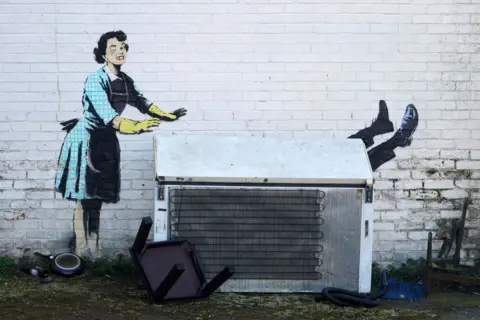 AFP
AFP
Sam was lying in bed one morning when her tenant in a house she owned in Margate sent her a photo of a piece of graffiti that had appeared on the wall outside.
Astonishingly, it looked like a Banksy. It would turn out to be perhaps the graffiti artist's most interesting new artwork of recent years, Valentine's Day Mascara (pictured above), which was revealed in Margate on Valentine's Day, 2023.
Bamboozled, Sam googled: what do you do when you wake up with a Banksy on your wall?
"What did Google say about that?" I asked her.
"Nothing! And I was like, I need to contact the council, I need to find an art gallery who can advise me."
Sam called Julian Usher at Red Eight Gallery. Julian's team, conscious that new Banksy's are under immediate threat from street cleaners, the weather, rival graffiti artists and other art dealers, promised he'd be in Margate within the hour: "We knew we had to get the piece covered," say Julian.
And there was another reason Julian got to Margate double-quick: if Banksy chooses your wall for one of his drawings, you could be seriously in the money.
For the second season of my BBC Radio 4 podcast The Banksy Story, which is called When Banksy Comes To Town, I've been following the very different fates of two sets of homeowners who wake up one day to find a Banksy on their wall. The season shows just how important his graffiti becomes for a local community – and why people disagree so vehemently about what should happen after it's discovered.
Sam became the custodian of Valentine's Day Mascara, which speaks to the theme of domestic violence, incidents of which usually spike each Valentine's Day. It's a complicated bit of work. A peppy 50s housewife with a black eye has bludgeoned her partner. A real pan with flecks of red is at her feet, and his painted legs are upended into the real fridge-freezer that Banksy left by the wall. A broken plastic chair testifies to the fight they have had.
Later on the day it appeared, refuse collectors arrived to spirit away the fridge-freezer. This precipitated a free-for-all, with the public helping themselves to the remnants. It was mayhem.

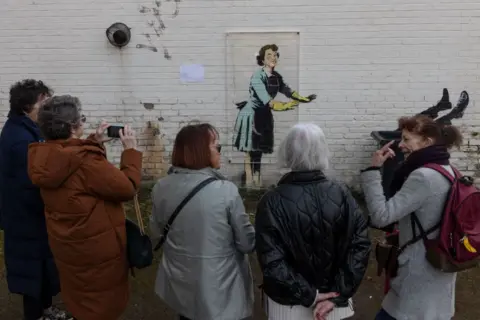 Getty Images
Getty Images
Members of the public quickly arrived to see the art and parts of it were later removed
A media scrum, a wrong-footed local council, millions of global onlookers. Exactly, one suspects, what Banksy wanted.
And this time, just for laughs, he left behind oil painter Peter Brown, commissioned to capture the scenes he would miss. I spoke to Pete "The Street" Brown for my series. "The whole reason I was employed was because Banksy was questioning what was the art about," Pete explained. "Is it about the graffiti? Or is it about the reaction afterwards, and what happens to it?"
As luck would have it, Pete was captured on video just as Banksy's team were putting the finishing touches to Valentine's Day Mascara – a video that The Banksy Story managed to obtain. In it we can see that one of Banksy's team let a local kid play with their drone.
Is this a glimpse of Banksy’s team in action?
"They're in the process of putting a large piece on a wall and yet they're taking the time to teach a kid how to fly a drone," says Steph Warren, who used to work with Banksy and who appeared in my first series - about the artist's rise and rise. "Very sweet!"
Alongside Sam, I've been following the story of Gert and Gary. They, like Sam, did not want me to use their last name. A 30ft-high seagull appeared one morning on the wall of their buy-to-let in Lowestoft in Suffolk. The bird needed to be massive for Banksy's ambitious visual gag to work. The artist had shoved large yellow insulation strips into a skip that now looked like a fast-food container that the seagull divebombed to steal chips.

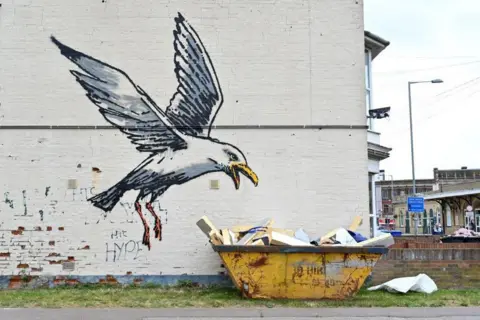 AFP
AFP
Banksy had chosen his wall well. Visitors arriving by train were treated to this witty meditation on the scourge of Britain's seaside towns, equal parts warning and celebration. The Lowestoft Seagull was part of Banksy's Great British Staycation, his post-Covid lockdown campaign to cheer us all up at the prospect of a summer holiday spent in the UK.
But Gert was not cheered-up at all. "It's not a seagull, it's an albatross!" she quipped when I went to interview her.
"How did you know it was a Banksy?" I asked.
"There was scaffolding erected on the side of the house. I tried to find out if it was a particular scaffolding firm, but there was no phone number," Gert replied. "On the Monday morning the letting agency informed me that I could possibly have a Banksy. By then the scaffolding had gone and this seagull appeared."
This fits with what we know of Banksy's modus operandi. He claims hiding in plain sight is the best way to remain invisible. "If questioned about your legitimacy," he wrote in his book Wall & Piece, "simply complain about the hourly rate."
It's a good gag. But how fun is it for the folk on the other end of his spray can?
I found that with good hustling skills a Banksied homeowner might see their bank balance expanded, but it's not an easy process.
As Gert explains, exasperated, "Lowestoft people commented that it belongs to Lowestoft… But nobody's turned up to say, 'we'll help you protect it'. It doesn't belong to the person filming it, or the person taking pictures with their children. The problem is mine!"
Gert had to contend with people putting their children into the skip for photo opportunities, the council trying to charge her for Perspex screens, and the threat of a Preservation Order which might have cost her £40,000 a year.

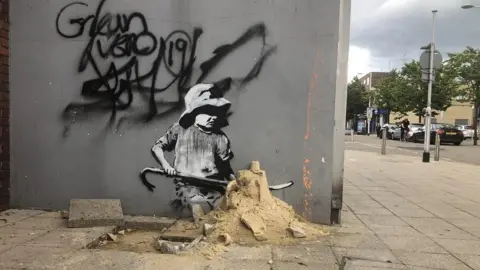 Andrew Turner/BBC
Andrew Turner/BBC
The seagull isn't the only Banksy in Lowestoft - this artwork depicting a child near a dug-up pavement appeared in 2021
And the two stories I've been following have ended up having entirely different outcomes.
Both artworks have been taken off the houses they were painted on – a complex, expensive operation that uses specialist equipment – so they can be sold. But while the Banksy in Margate is now on the verge of selling for well over £1m, with a sizeable chunk set to go to a domestic violence charity, and with the piece remaining in the town for the foreseeable future, the Banksy up the coast in Lowestoft languishes in a climate-controlled warehouse, costing its owners £3,000 per month.
It has cost Gert and her partner Gary around £450,000 so far to preserve the piece and although there are buyers sniffing around, nobody has bought it yet. Speaking about the situation, Gary told me: "I'm so angry at what's going on."
Not everyone approves of people trying to sell Banksy's street art.
Steph Warren – who starred in the first series of The Banksy Story as the only person ever to work for Banksy without signing his non-disclosure agreement – suggests that worried homeowners should simply "get busy with five litres of white emulsion and paint it out".

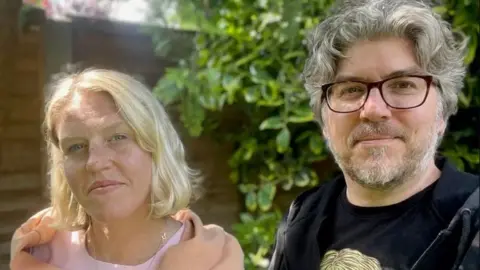 James Peak
James Peak
Steph Warren (left) with podcast host James Peak
Owner of street-art gallery Stelladore in St Leonards, Warren is a purist, who feels that art made for the street should remain there, no matter it's value. "With Banksy, where he puts the art is fundamental," she says. "Remove the work from the precise place on the streets that he put it, and the work instantly loses its power. Context is everything."
But Banksy has elevated graffiti into a new art form, now monetised – street art. Banksy's signed prints can sell for six-figure sums. Graffiti, or street art, has not just come of age, it is now an asset class. Given this, how can any homeowner feel okay about scrubbing away a Banksy without feeling as if they have smashed a Ming vase?
One thing I know for sure: if you wake up with a Banksy on your wall, you'll have to make a series of clever decisions to come out of it unscathed. As Sam says, after two years of dealing with the Banksy circus, "going back to normal life now is going to be terribly boring".
- The new season of The Banksy Story is available on BBC Sounds

 1 month ago
23
1 month ago
23

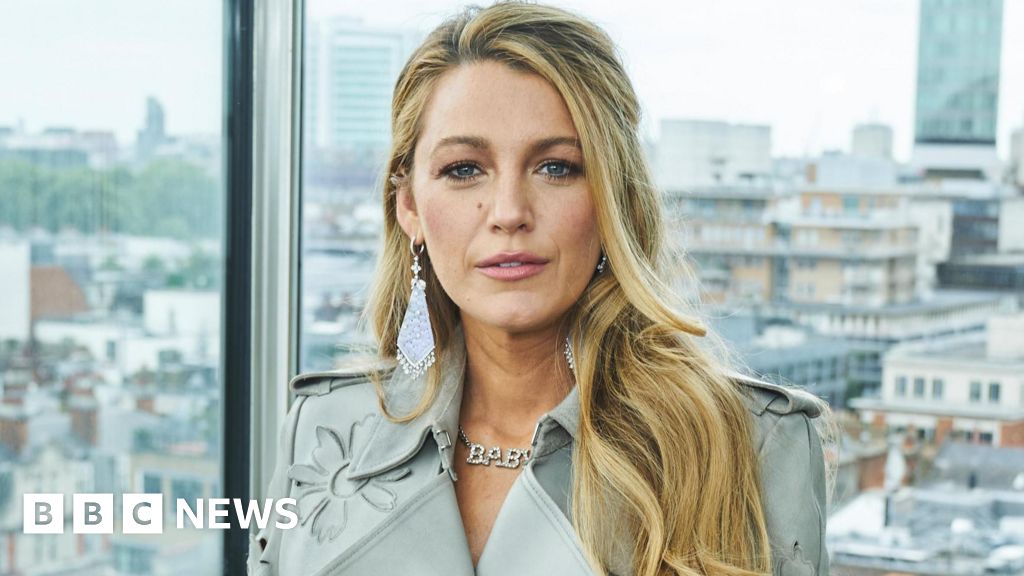

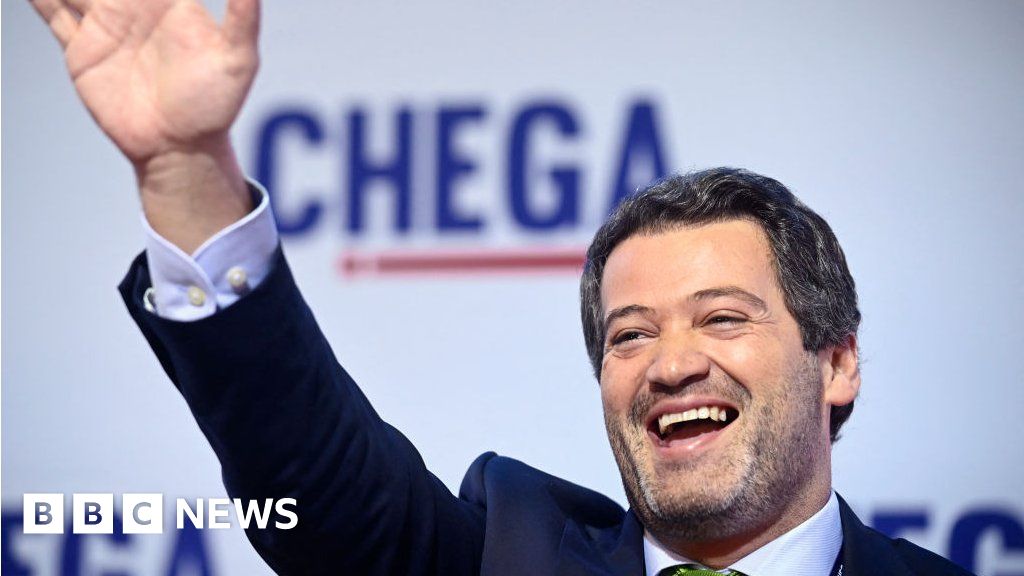

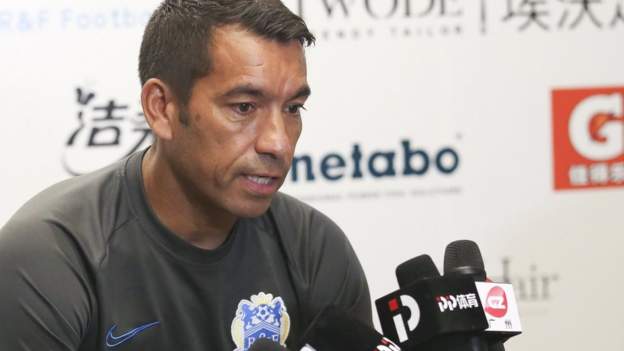


 English (US) ·
English (US) ·